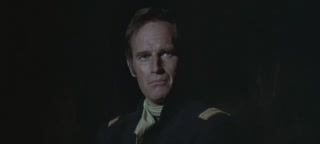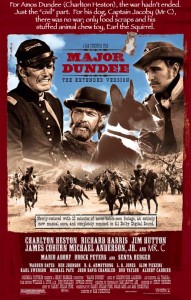
THE EPIC STORY OF THE GREAT SOUTH-WEST !
Major Dundee is a picture with a soap opera past that is almost more interesting than the picture itself. It marks Sam Peckinpah’s second feature film, following its predecessor Ride the High Country by three years. On paper, it’s a great film. With a (eventually) storied director and boasting an exceptional cast – Charlton Heston, Richard Harris, and James Coburn it has all the needed ingredients to be a success. In smaller parts throughout you’ll find many character actors who became regulars in Peckinpah films. On celluloid, it’s something different altogether. And unless you are a die hard fan of one of the leads this feature is best left on the shelf.
The boilerplate plot is rather straightforward. Heston portrays Major Amos Dundee, a military officer who has been demoted to prison duty after undue heroics at the battle of Gettysburg. (Exactly what these actions were is never explained.) the picture opens immediately after an Apache raid which during which several young children are kidnapped. Unable to muster enough blue-coats to mount a serious chase, Dundee is forced to impress many Confederate prisoners-of-war and freedmen to join in helping his efforts.
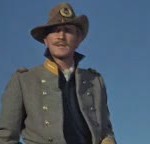 Richard Harris plays the commanding Confederate officer, Captain Benjamin Tyreen. Tyreen and Dundee were friends before the war but have since gone their separate ways. During their pursiut of the Apaches Dundee’s band crosses into French controlled Mexico. So on top of fighting (or at least chasing) the Apaches- which the viewer wants to see we are subjected to the muddled inclusion of clashes with the French as well.
Richard Harris plays the commanding Confederate officer, Captain Benjamin Tyreen. Tyreen and Dundee were friends before the war but have since gone their separate ways. During their pursiut of the Apaches Dundee’s band crosses into French controlled Mexico. So on top of fighting (or at least chasing) the Apaches- which the viewer wants to see we are subjected to the muddled inclusion of clashes with the French as well.
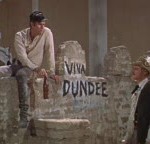 And along the way we stop at a Mexican town in the middle of nowhere. Luckily an Austrian doctor is in residence, but her pressence appears to be merely window dressing as her character (like oh so many others here) contribute absolutely nothing to the plot whatsoever.
And along the way we stop at a Mexican town in the middle of nowhere. Luckily an Austrian doctor is in residence, but her pressence appears to be merely window dressing as her character (like oh so many others here) contribute absolutely nothing to the plot whatsoever.
Having not seen the original (and much aligned) theatrical release, I can only comment on the recently released DVD which restores roughly thirteen minutes of footage which was presumed lost. It is believed that a bit over thirty minutes of completed footage remain lost- presumably for good. So this is probably as close to the director’s vision as we are likely to see, but as to how close we will never know.
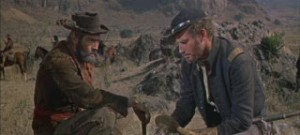
The new DVD also adds a completely new musical soundtrack, which somehow seems also to not improve the film much, although it does do a fairly good job of recreating the Western soundtrack sound of that era- say of an Elmer Bernstein for example. In some instances the original soundtrack (which Peckinpah reportedly loathed) works better, even though in many places it appears out of synch with the picture and the music for the Mexican village is completely irritating.
One would like to say that the added footage helps but it is truly hard to say. The first third to first half of the picture is quite good and seems to follow a fairly decent path. Heston’s usual lack of expression works well here for some reason, although Richard Harris steals the show. The later portions of the movie in particular seem so horribly confused and out of place as to lead one to believe that they were directed by another- or perhaps by no one.
We are taken down several subplots which go nowhere and we see many potentially interesting characters literally disappear from the action without explanation. This leads to the general air of frustration and confusion the viewer has increasingly during the run time.
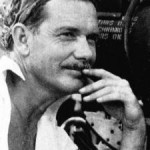 Heston himself in his autobiography “In the Arena” has quite a bit to say about the struggle to bring Major Dundee to completion. One senses that Heston is being a bit diplomatic when he relates tales of Peckinpah’s whoring and overdrinking. According to the star he palled out late with the director more to keep the picture alive than anything else- Peckinpah had already alienated everyone else on the set.
Heston himself in his autobiography “In the Arena” has quite a bit to say about the struggle to bring Major Dundee to completion. One senses that Heston is being a bit diplomatic when he relates tales of Peckinpah’s whoring and overdrinking. According to the star he palled out late with the director more to keep the picture alive than anything else- Peckinpah had already alienated everyone else on the set.
Other issues in production included a completely unfinished script when shooting began, long daily drives to on-location shoots in extremely rural Mexico, and Peckinpah’s well-documented struggles with producer Jerry Bressler- struggles which forced Heston to volunteer his salary for the picture in order to keep the director on the project. Ultimately Peckinpah wasn’t allowed into the cutting room to edit the picture (so it is said) and Peckinpah disowned the picture- to the point of declining the option of reshooting certain sequences after The Wild Bunch became a smash.
One can see pieces of what would eventually become Peckinpah’s masterpiece, The Wild Bunch, which according to Heston was the film Sam was really out to make. Unfortunately the studio wanted something as close to a John Ford picture as possible and the leading man (Heston) wanted to do a realistic portrayal of the Civil War. This complete divergence of goals perhaps is the root cause of much of the film’s flaws.
As a somewhat humourous aside, Heston also relates how after one particularly long day Peckinpah ordered a retake of Dundee’s troop coming down a hill in the day’s fading light. After some verbal abuse of Heston and a debate over cantering versus trotting, the mounted Heston charged his director with sabre swinging. Luckily Peckinpah was lifted up just in time to avoid his charging star.
The film is probably best thought of as a rough outline for The Wild Bunch, as you can see some of the action sequences begin to coalesce as they would in later Peckinpah films. As a nice touch during the final river fight with the French the water literally turns red around wounded men and horses. I haven’t seen that in any other films, especially from that era.
